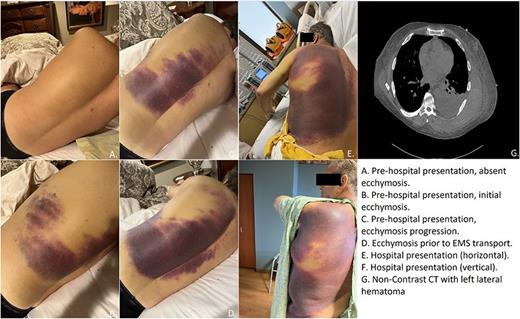Abstract
INTRODUCTION: Unpredictable coagulopathy in liver cirrhosis has been well established. Alterations in liver function can lead to both anticoagulant and procoagulant effects as both fibrinolytic factors and most coagulation factors are produced in the liver. With poor synthetic function, and reduced elimination potential fibrinolysis can be enhanced resulting in large ecchymosis and increased morbidity and mortality. A case is presented to illustrate how a patient with alcohol induced liver cirrhosis develops accelerated intravascular coagulation and fibrinolysis (AICF) with no inciting event and how tranexamic acid can be used to aid treatment.
CASE: A 58-year-old male with alcoholic cirrhosis was seen in the Emergency room for significant ecchymosis, chest and lower back pain with no known cause. While abstinent from alcohol and on no antiplatelet or anticoagulant medication, patient had approximately two weeks of symptoms and one bout of near syncope. On presentation, patient was tachycardic, hypotensive, weak and fatigued, with yellow sclera. Extensive bruising was present on the back and left flank. MELD score on admission was 26. EKG done on arrival showed a new infarction not present on prior EKG's. Patient was admitted to the intensive care unit (ICU) after a hemoglobin of 4.0 g/dL was noted and CT scan of the abdomen and pelvis showed an acute left posterolateral thoracic intramuscular hematoma, hepatic cirrhosis, splenomegaly, and marked ascites within the peritoneal cavity.
Platelet count was 101 K/uL, partial thromboplastin time (PTT) was 49.3 and the international normalized ratio (INR) value was 4.4. Fibrinogen was critically low at 67 while the ADAMTS13, and factor VIII activity were normal. The peripheral blood smear (PBS) appeared depleted with a mild to moderate amount of schistocytes.
The diagnosis of accelerated intravascular coagulation and fibrinolysis was made. During the first day, patient required eight transfusions: two units each of packed red blood cells, fibrinogen, fresh frozen plasma, and cryoprecipitate. Despite supportive management with fluids and multiple blood products, patients' values only stabilized at their admission values. With this, patient was provided three doses of 10 mg vitamin K, and 10 ml tranexamic acid every eight hours for three days (nine total dosages). Once tranexamic acid was initiated, the supportive supplementary blood products required significantly dropped. During this hospitalization and after discharge, patients MELD score improved from 26 to 17.
DISCUSSION: Coagulation is a complex process, however, with the superimposed diagnosis of liver cirrhosis this balance is further complicated. The process of liver failure has both anticoagulant and procoagulant effects. In hyperfibrinolysis, clots are broken down prematurely. AICF is the term used to describe combined intravascular coagulation and prolonged bleeding. Quick definitive diagnosis of ACIF is difficult to make but crucial. With quick detection, prompt use of blood products and the initiation of tranexamic acid to stabilize the fibrin matrix a patient with a hemoglobin of 4.0 can be given the tools and time needed to recover.
Disclosures
No relevant conflicts of interest to declare.
Author notes
Asterisk with author names denotes non-ASH members.


This feature is available to Subscribers Only
Sign In or Create an Account Close Modal